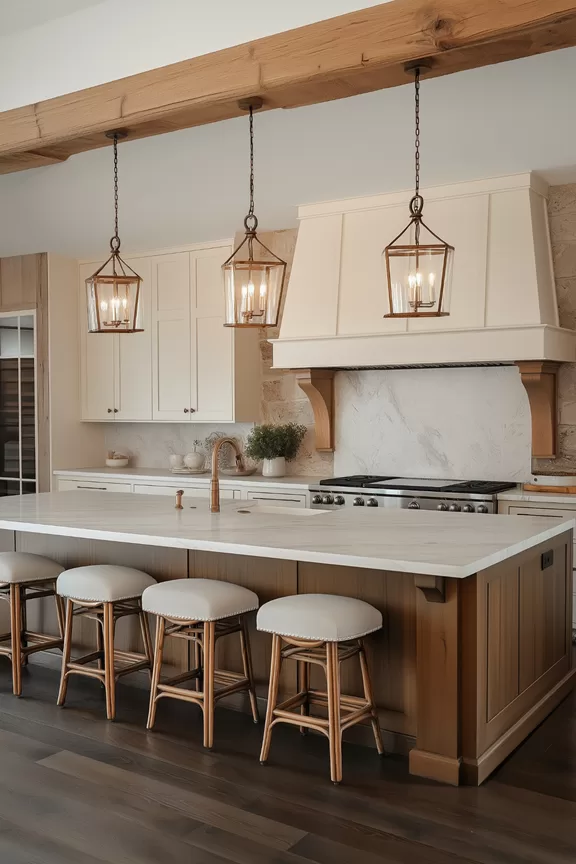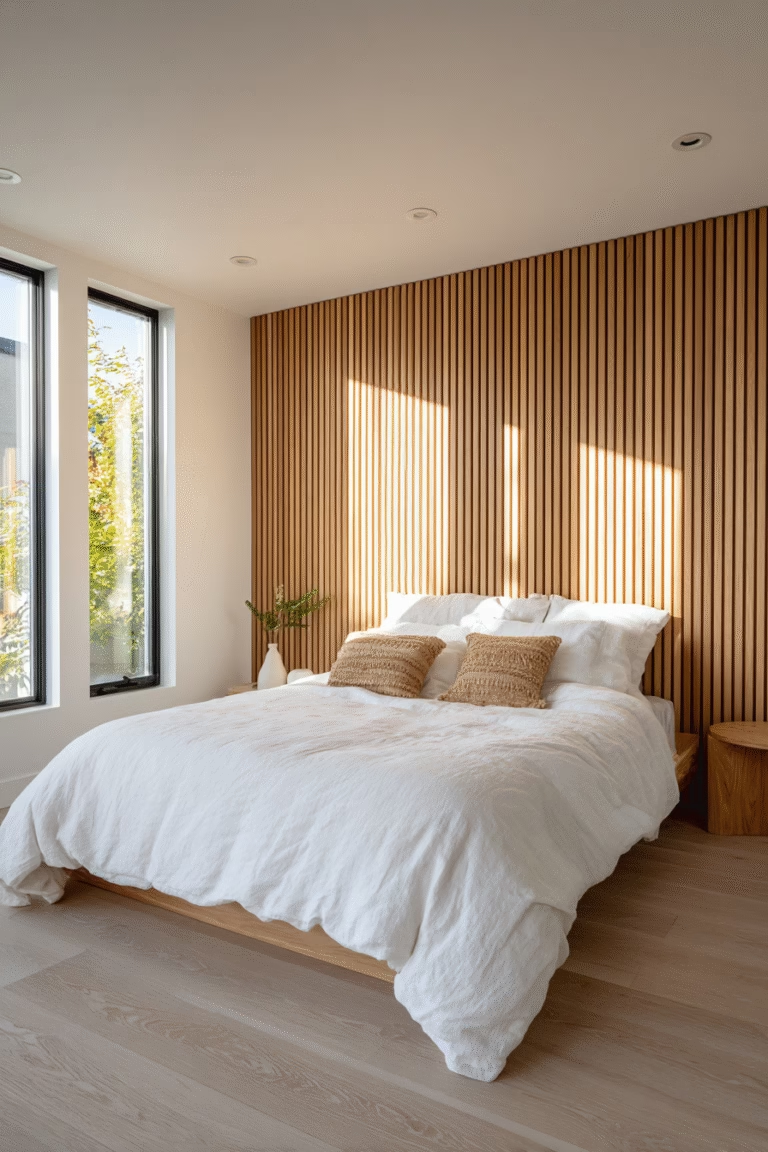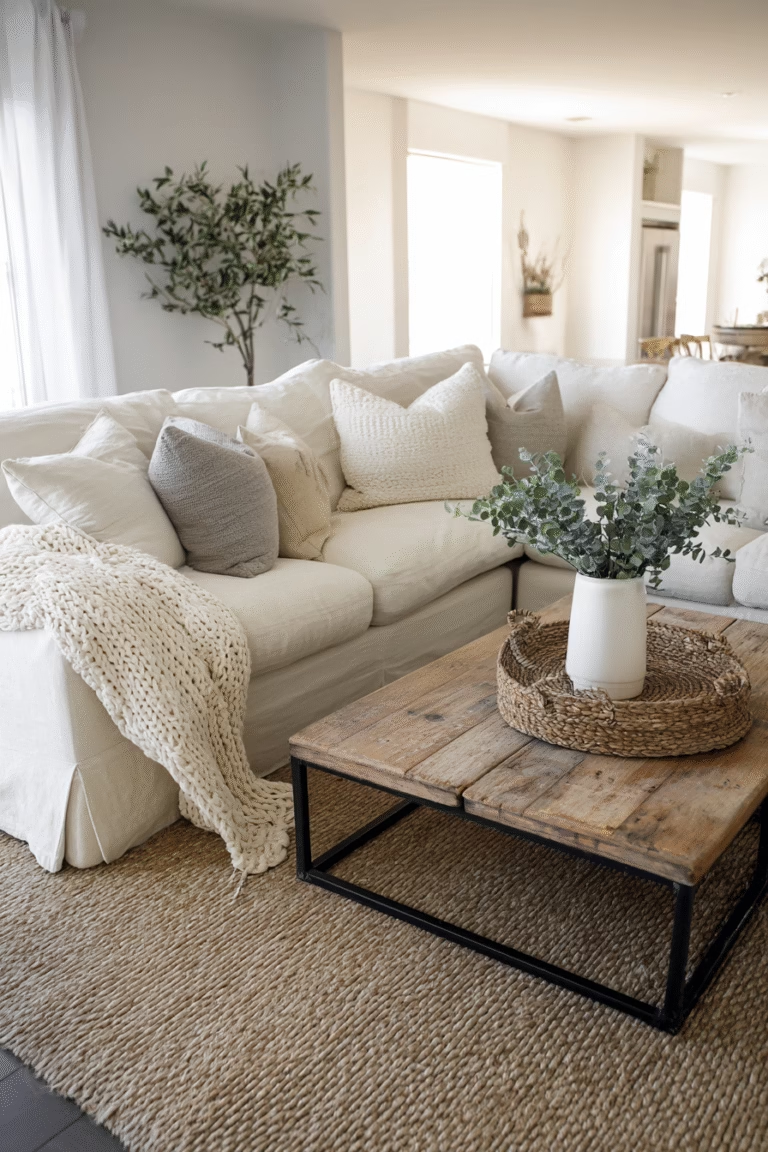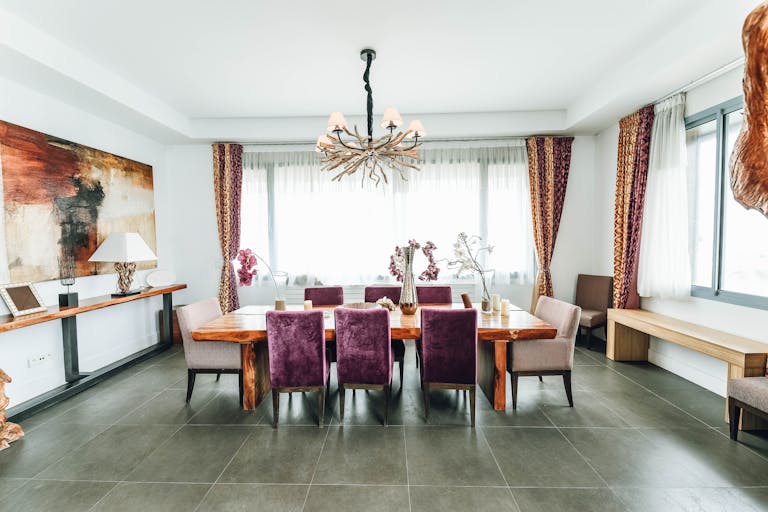22 Japandi Dining Room Ideas for A Gorgeous Look
This site contains affiliate links. As an Amazon Associate, I earn from qualifying purchases. The content on this website was created with the help of AI. Please read our Editorial Policy for more information.
Ever walk into your dining room and feel like something’s just… off? Too much clutter, too many mismatched pieces, or maybe it just doesn’t feel like a place where you actually want to sit down and have dinner?
Here’s the thing: your dining room doesn’t need a complete overhaul to feel better. The japandi dining room style blends Japanese minimalism with Scandinavian warmth to create spaces that feel peaceful without looking cold or boring. Think clean lines, natural wood, and a color palette that won’t make your eyes work overtime.
Look, you don’t need to be an interior designer to pull this off. These 25 japandi dining room ideas will show you exactly how to create a dining space that feels calm, functional, and actually inviting—without turning into a weekend project that takes over your life.

22 Japandi Dining Room Ideas for A Gorgeous Look
1. Light Oak Dining Table
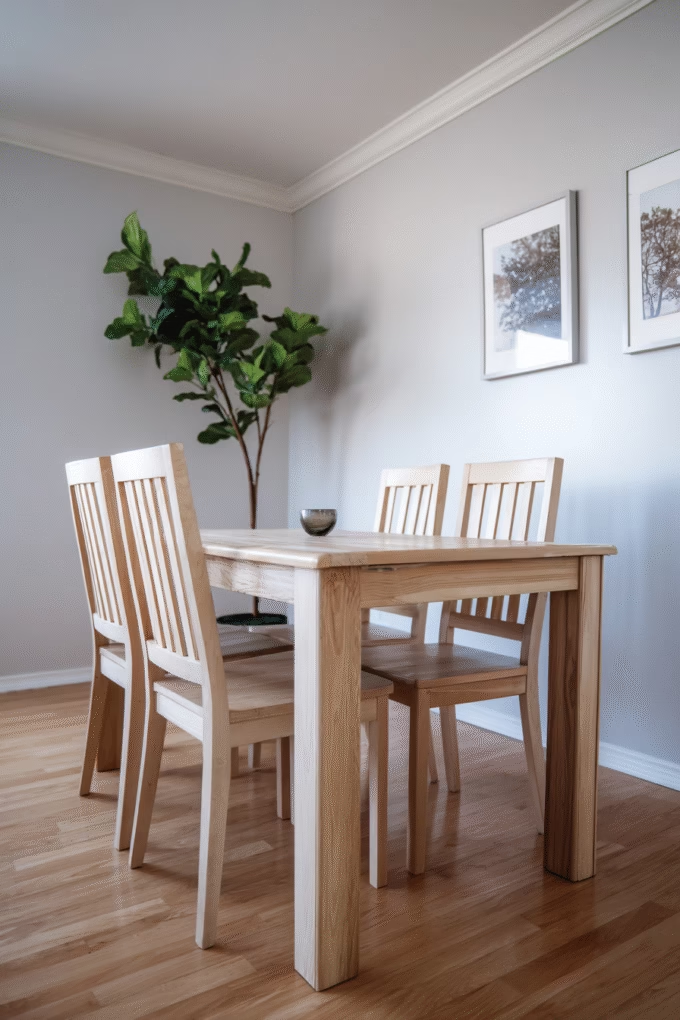
Start with a solid wood table in light oak or ash. The natural grain adds warmth without overwhelming your space, and the light tone keeps things feeling open and airy rather than heavy.
Choose a table with simple, straight legs—nothing ornate or fussy. The beauty comes from the wood itself, not from carved details or decorative elements. A rectangular shape works great for most spaces, though round tables create a cozy vibe in smaller dining areas.
Pair it with simple chairs that don’t compete for attention. The table should be your foundation piece, setting the tone for everything else in your japandi dining room.
2. Low-Profile Bench Seating
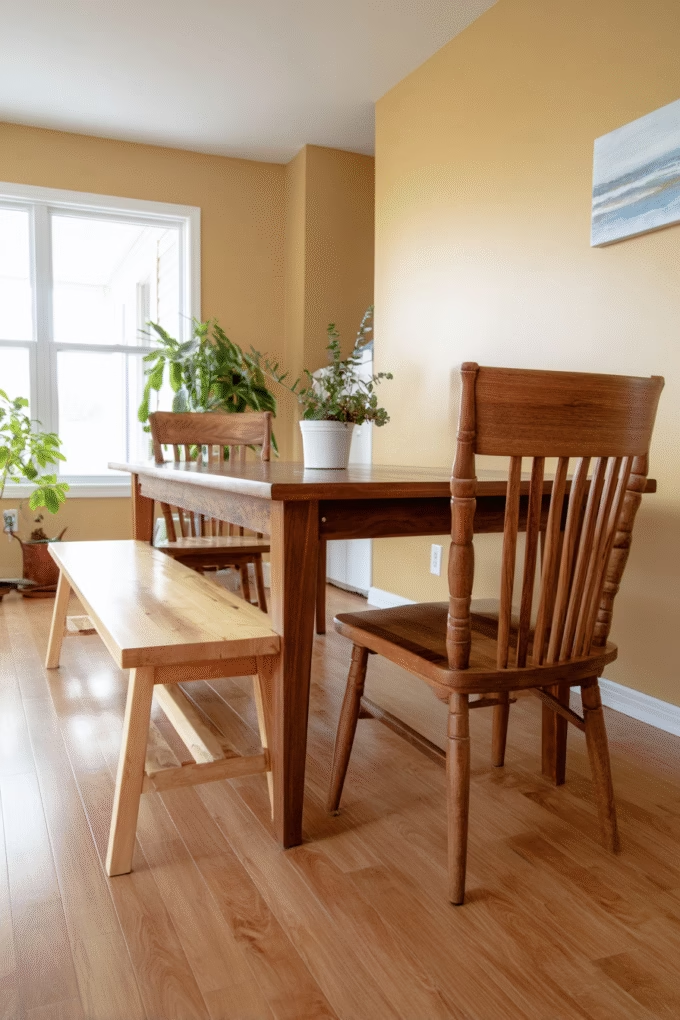
Swap out traditional chairs on one side of your table for a low-profile wooden bench. This Japanese-inspired seating creates a more casual, flexible dining setup and makes your space feel less formal.
Benches work especially well for families with kids—more people can squeeze in when needed, and there are no individual chair backs to climb over. Plus, they tuck completely under the table when not in use, opening up your floor space.
Look for benches with clean lines and a wood finish that matches your table. Skip the cushions if you want to keep things truly minimal, or add a simple linen cushion in a neutral tone for extra comfort.
3. Neutral Linen Table Runner
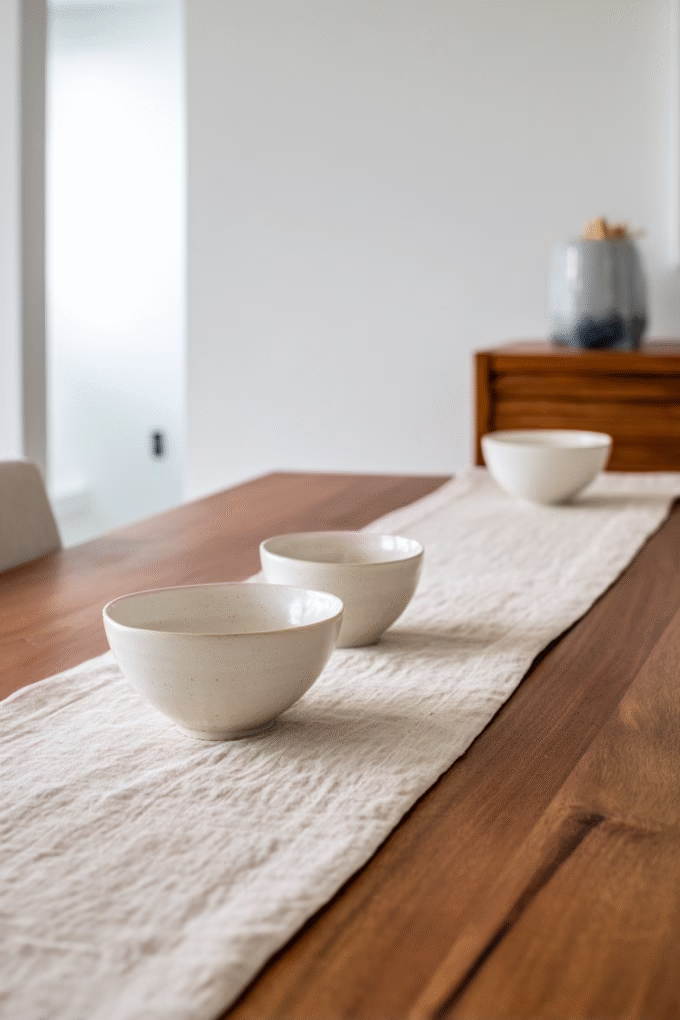
Add texture to your japandi dining room table with a simple linen table runner in beige, cream, or soft gray. The natural fabric brings warmth while maintaining that minimalist aesthetic you’re going for.
Linen has a relaxed, lived-in quality that prevents your dining space from looking too sterile or cold. The subtle texture catches light beautifully and adds visual interest without pattern or color.
Keep it simple—one runner down the center of the table, nothing fancy. Skip the placemats underneath unless you’re actually using them for a meal. The idea is to add one thoughtful layer, not pile on the textiles.
4. Bamboo Pendant Light
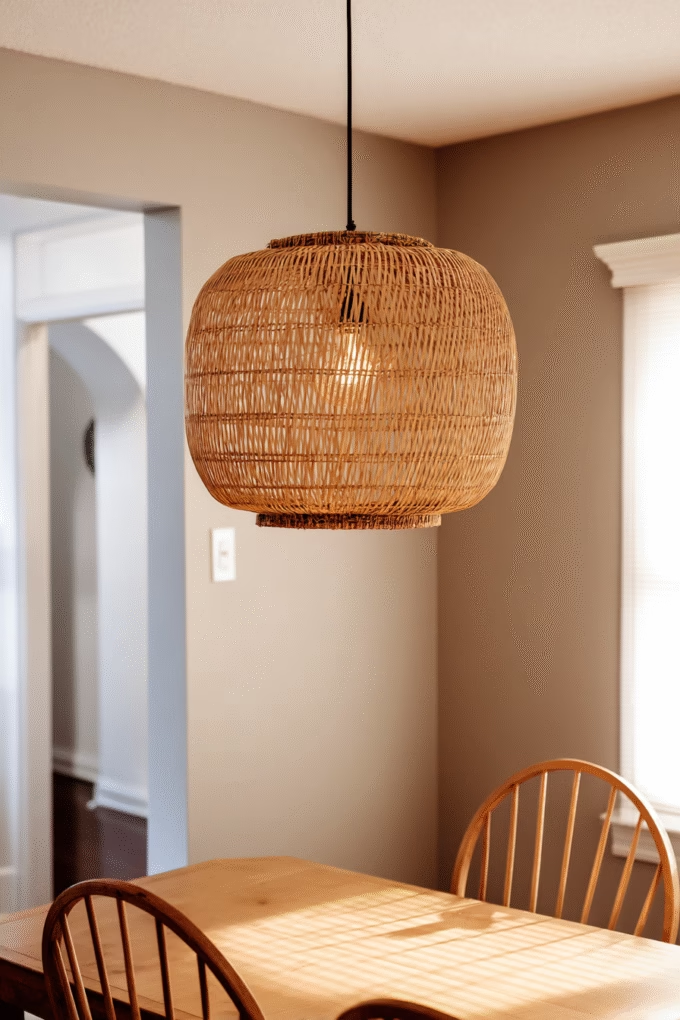
Hang a woven bamboo pendant light above your dining table for soft, filtered lighting that creates the perfect ambiance. The natural material ties into the japandi aesthetic while adding an organic sculptural element.
Position the light about 30 to 36 inches above your table surface—high enough that no one bumps their head, low enough to feel intimate. The woven design casts beautiful shadows and creates visual interest on your ceiling and walls.
Choose a light with a simple, rounded shape rather than anything too elaborate. The goal is to add warmth and texture, not to make a dramatic statement that fights with the rest of your space.
5. Matte Black Accents
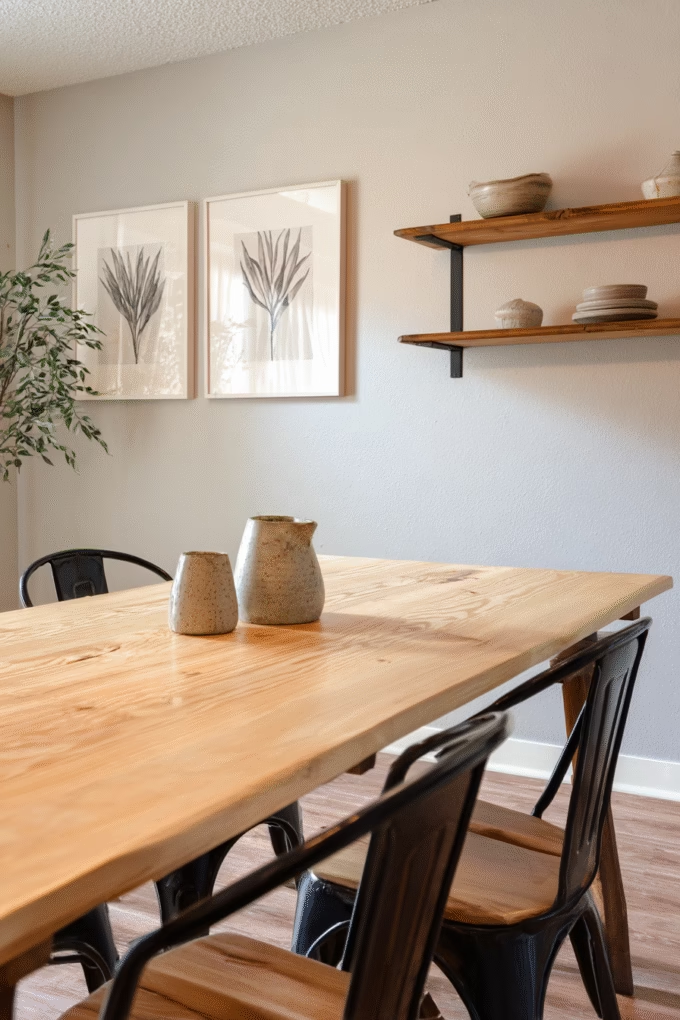
Introduce depth to your neutral japandi dining room with small doses of matte black. Think cabinet hardware, light fixtures, or chair frames—just enough to create contrast without overwhelming the space.
Black grounds your design and prevents that washed-out look that can happen with too much beige and white. The matte finish keeps things sophisticated rather than shiny or industrial.
Use black sparingly—maybe 10 to 15 percent of your visible elements. Too much and you lose that light, airy feeling that makes japandi dining rooms so appealing in the first place.
6. Floating Wooden Shelves
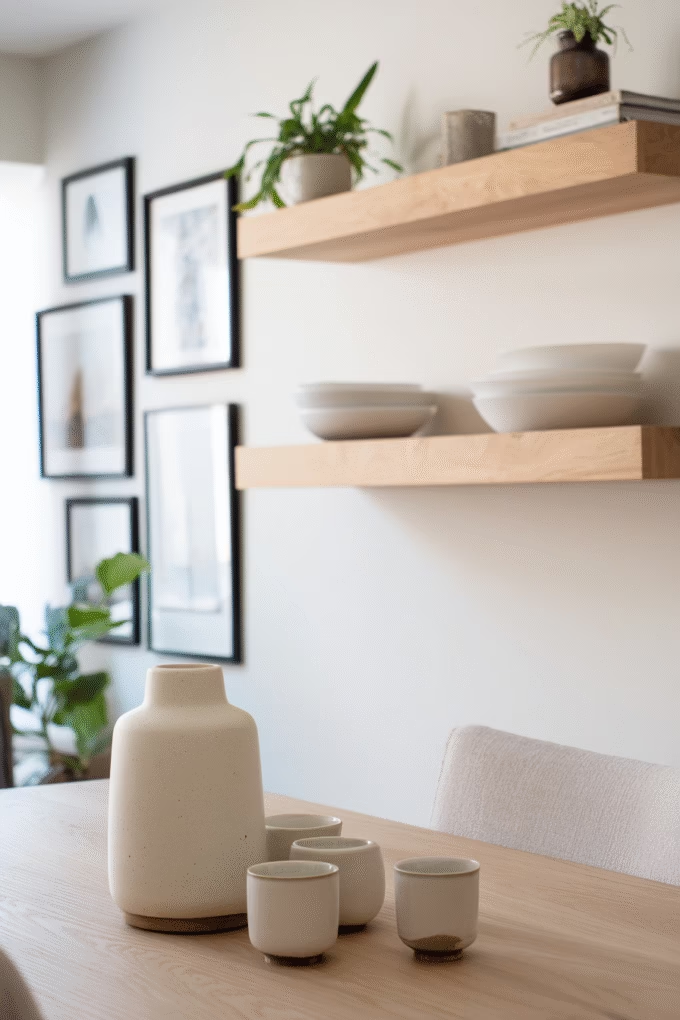
Install simple floating shelves in light wood to display your ceramics and glassware. This keeps your everyday items accessible while adding functional storage that doesn’t interrupt your clean lines.
Keep your display edited—a few carefully chosen pieces look intentional, while a crowded shelf just looks messy. Think handmade bowls, simple vases, or a small collection of neutral-toned ceramics.
Mount the shelves at a comfortable height where you can easily reach what you need. Three shelves usually work better than two or four—odd numbers create better visual balance.
7. Simple Ceramic Dishware
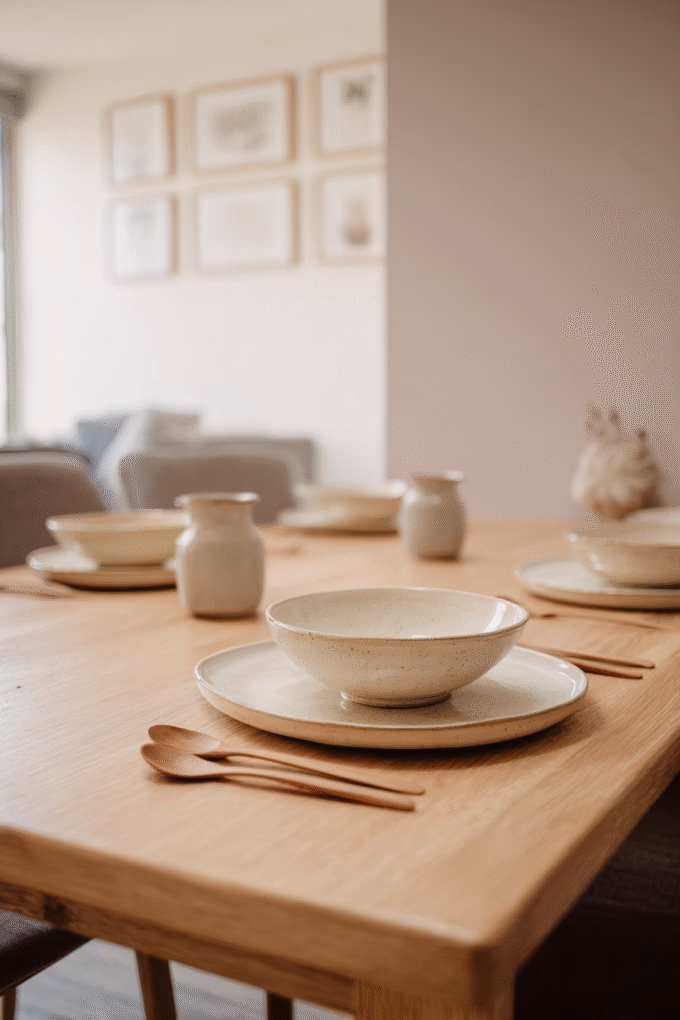
Invest in handmade or artisan ceramic plates and bowls in soft, earthy tones. The slightly imperfect, handcrafted quality celebrates the Japanese wabi-sabi philosophy—finding beauty in imperfection.
Choose pieces with subtle variations in glaze or texture rather than perfectly uniform commercial dishware. Creams, soft grays, and natural clay tones work beautifully and hide stains better than pure white.
You don’t need a full 12-piece set—start with four to six place settings in your japandi dining room. Quality matters more than quantity, and fewer pieces mean less clutter in your cabinets.
8. Rattan Storage Baskets
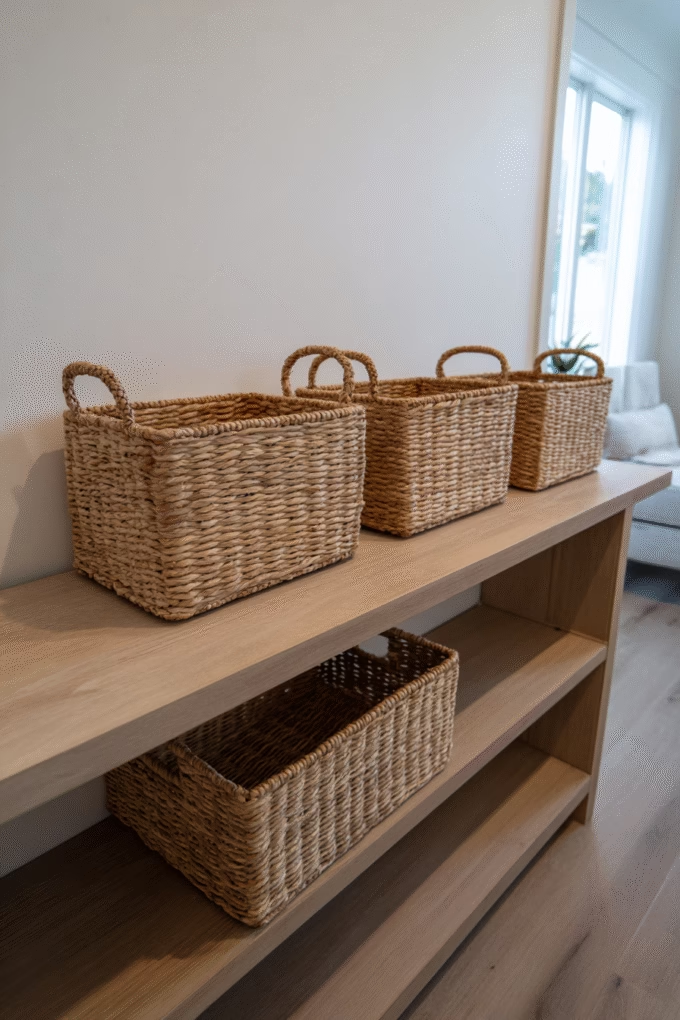
Use natural rattan baskets tucked under a console or sideboard to hide table linens, extra dishware, or serving pieces. The woven texture adds warmth while keeping clutter completely out of sight.
Choose baskets in natural, unstained rattan—skip the painted or colored versions. Look for simple, boxy shapes with or without handles, depending on whether you need to pull them out frequently.
Size matters here. Measure your cabinet or shelving space before buying so your baskets actually fit. Nothing ruins the minimal vibe faster than baskets that stick out awkwardly or don’t slide in properly.
9. Sheer White Curtains
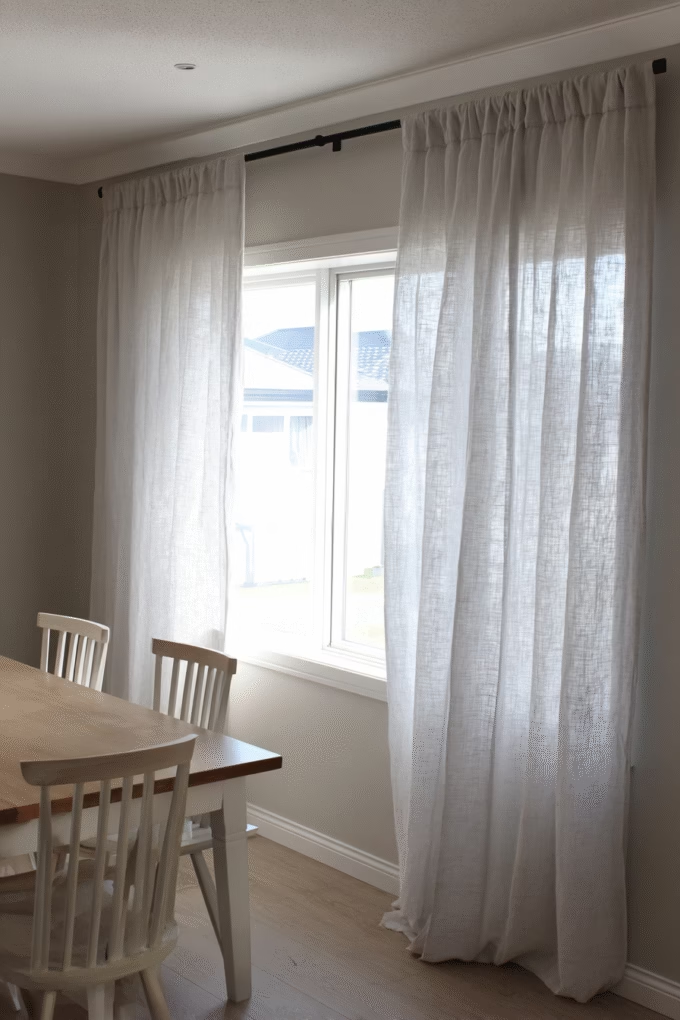
Hang simple, sheer white curtains to filter natural light without blocking it completely. This creates that soft, diffused glow that makes japandi dining rooms feel so peaceful.
Skip heavy drapes or anything with patterns. Plain white or cream linen-look sheers in a simple tab-top or rod-pocket style work perfectly. The goal is to soften the light, not to make a design statement with your window treatments.
Hang your curtains high and wide—mount the rod close to the ceiling and extend it several inches past your window frame on each side. This makes your windows look larger and your ceilings feel higher.
10. Concrete Floor or Accent
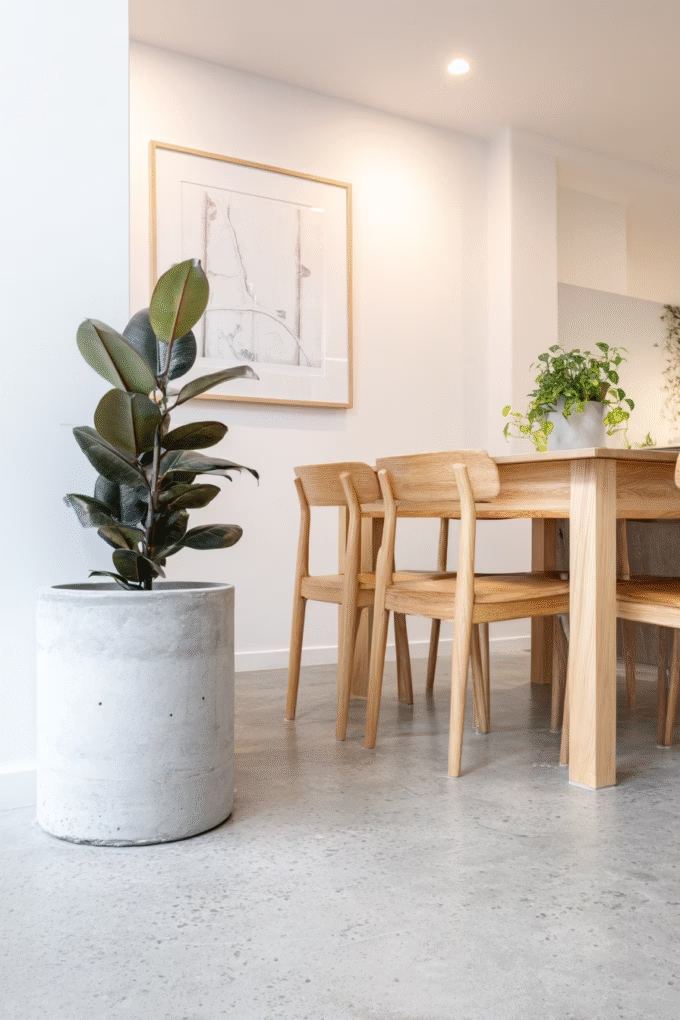
Consider concrete flooring or a concrete accent element like a plant stand or table base. The industrial material contrasts beautifully with the warmth of wood and creates that Japanese-meets-Scandinavian balance.
Concrete doesn’t mean cold and unwelcoming—when paired with natural wood and soft textiles, it actually grounds your space and adds modern sophistication. A polished concrete floor in light gray works especially well.
If concrete flooring isn’t in the cards, bring in the material through smaller pieces like planters, candle holders, or decorative objects. You get the visual contrast without the permanent commitment.
11. Minimalist Wall Art
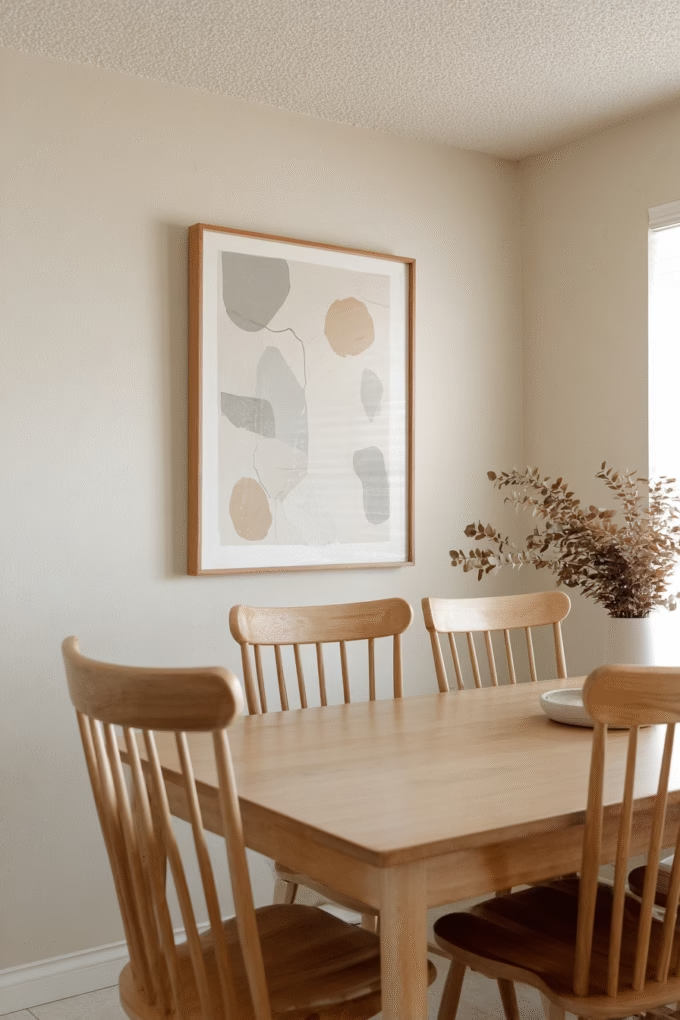
Hang one large-scale piece of minimalist art rather than a gallery wall. Think abstract landscapes in muted tones, simple line drawings, or photographs of natural elements—nothing busy or colorful.
The art should complement your space, not demand all the attention. Soft grays, beiges, blacks, and whites work best. Mount it at eye level, centered on your wall or behind your dining table.
Less is more here. One thoughtful piece creates a focal point, while multiple smaller pieces can make your japandi dining room feel cluttered and busy.
12. Open Sideboard with Clean Lines
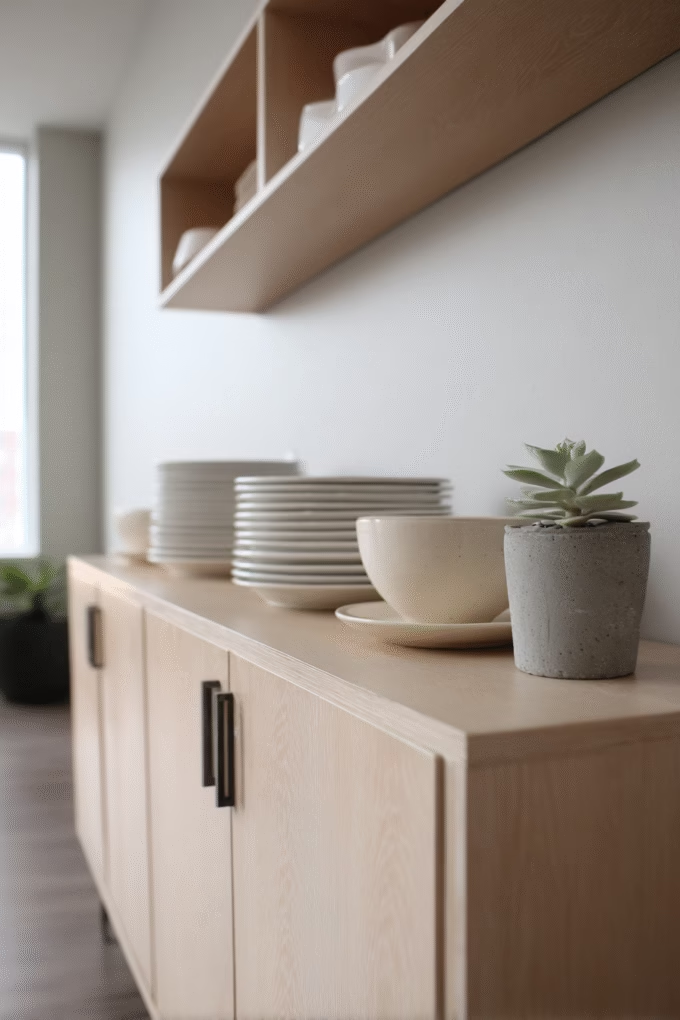
Choose a sideboard or credenza with open shelving and simple cabinet doors. This gives you storage for dining essentials while displaying a few beautiful objects that add personality to your japandi dining room.
Look for pieces in light wood with minimal hardware—maybe just recessed pulls or push-to-open doors. The legs should be slim and tapered, not chunky or ornate.
Style the open shelves with a careful edit of dishes, glassware, or simple decorative objects. Leave some empty space—every shelf doesn’t need to be full.
13. Faux Olive Tree in Corner
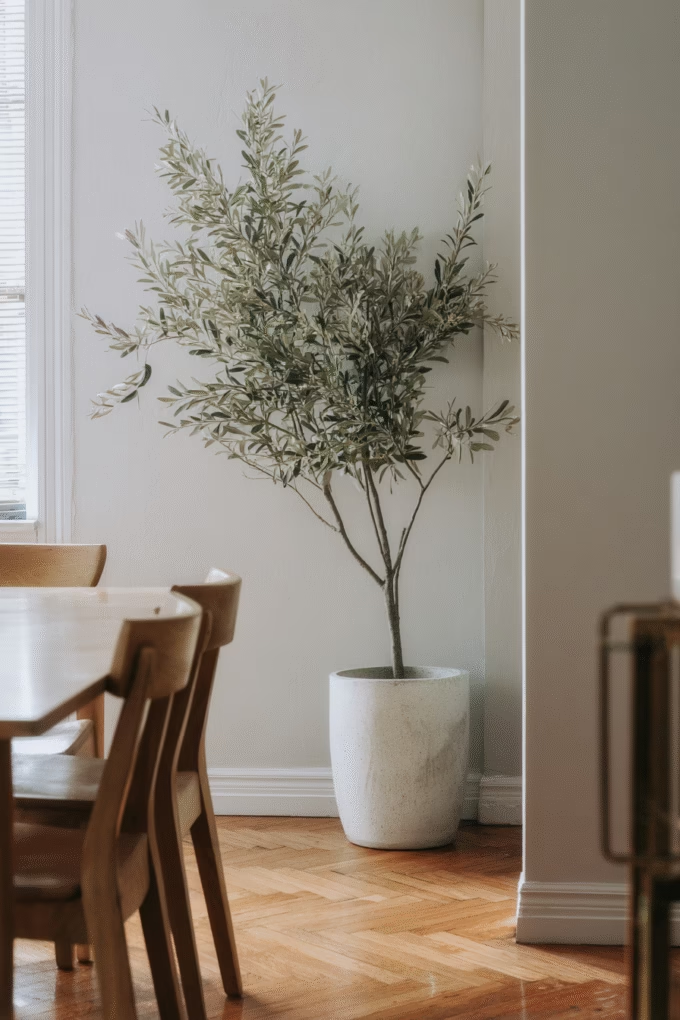
Add a tall faux olive tree in a simple planter to bring life and a connection to nature into your dining space. The silvery-green leaves add a subtle pop of color without disrupting your neutral palette.
Choose a tree that’s about five to six feet tall—big enough to make an impact, not so big it overwhelms your space. Place it in a corner or beside a window where a real tree would naturally thrive.
Skip the decorative pots with patterns or bright colors. A simple concrete, ceramic, or woven basket planter in natural tones keeps the focus on the tree itself.
14. Woven Placemats in Natural Fiber
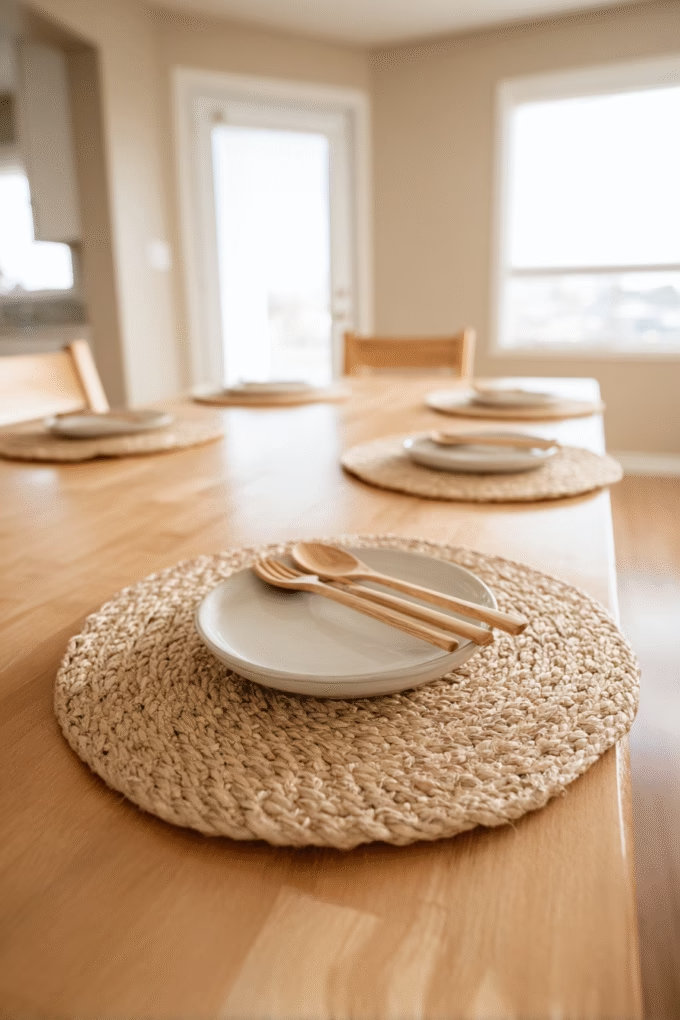
Use simple woven placemats in jute, seagrass, or bamboo to add texture to your table without adding color or pattern. They’re practical for protecting your table and create visual warmth.
Round or rectangular shapes both work—choose based on your plates and table shape. The natural color and texture is the whole point, so skip any dyed or painted versions.
Layer them under your ceramic dishware for meals, then remove them when the table’s not in use to keep things looking clean and minimal.
15. Slim Profile Dining Chairs
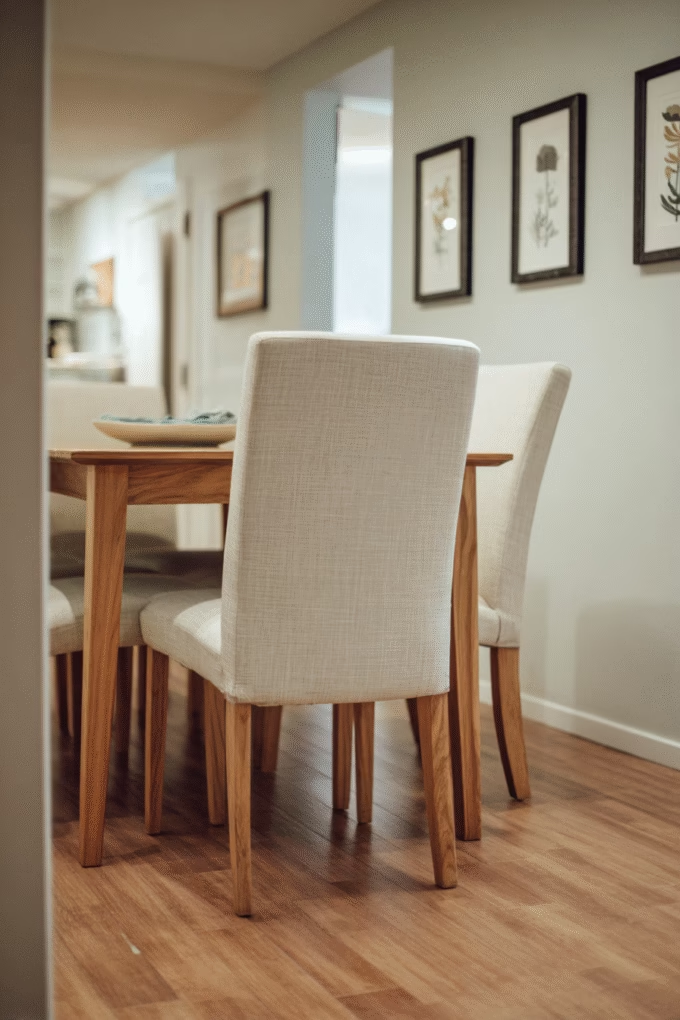
Select dining chairs with slim legs and minimal bulk. The delicate silhouette keeps your space feeling open rather than crowded, even when all the chairs are pushed in.
Wooden chairs with spindle backs or simple vertical slats work beautifully in japandi dining rooms. You can also go with upholstered seats in neutral fabric—just keep the back design clean and simple.
Make sure they’re actually comfortable. Minimalist doesn’t mean miserable. Sit in them before buying if possible or check the seat depth and back angle carefully.
16. Paper Lantern Pendant
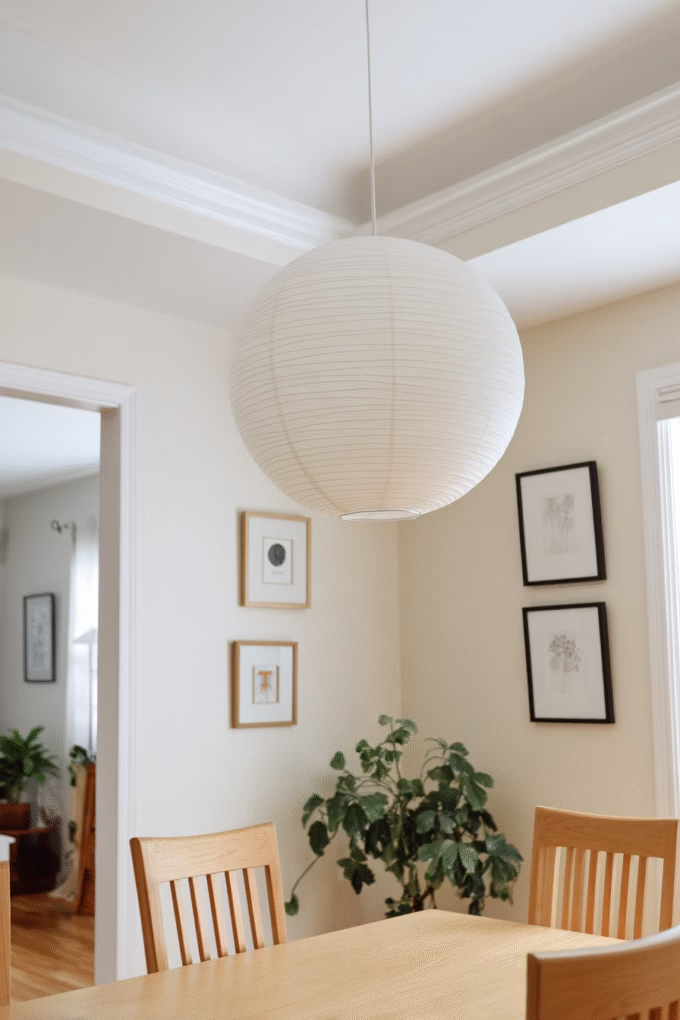
Hang a simple white paper lantern pendant for soft, diffused lighting that nods to traditional Japanese design. The spherical shape and gentle light create instant warmth and calm.
Choose a size that’s proportional to your table—too small looks dingy, too large overwhelms. For most standard dining tables, an 18 to 24-inch diameter works well.
Paper lanterns are budget-friendly, which is great. Just know they’re not heirloom pieces. Replace them when they get dusty or dingy—they’re meant to be simple and affordable.
17. Stone or Marble Accent Piece
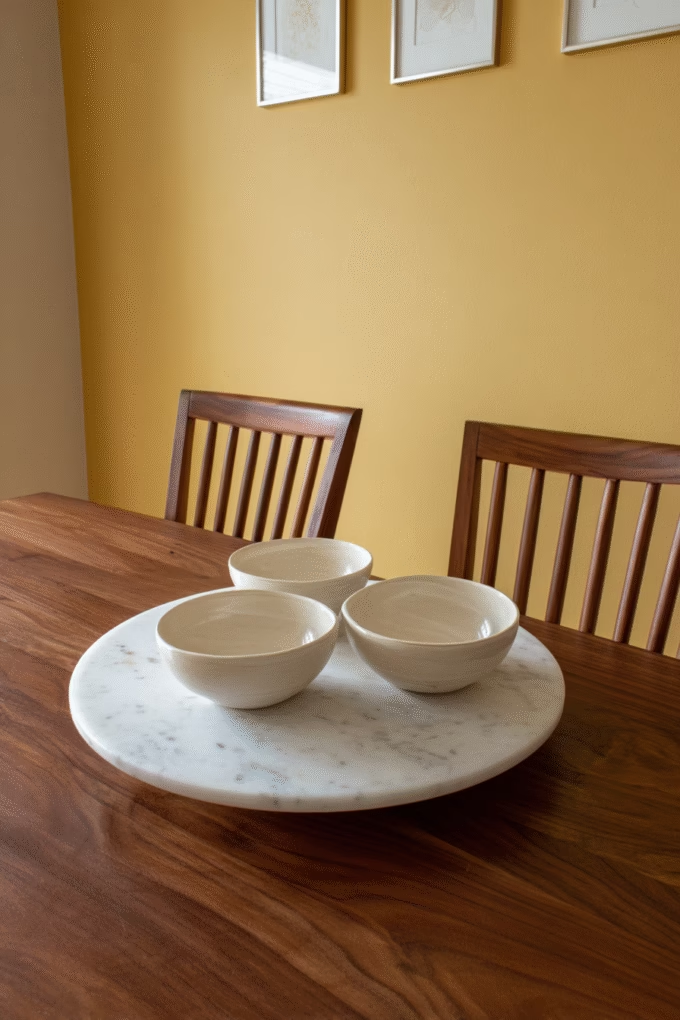
Introduce one piece in stone or marble—maybe a trivet, lazy Susan, or small tray. The cool, smooth material provides textural contrast against all that warm wood.
White marble or light gray stone works best. The veining adds subtle pattern without being busy, and the natural material ties into the whole organic, earthy vibe.
Keep it functional. A marble cheese board or lazy Susan serves a purpose while adding that sophisticated touch to your japandi dining room.
18. Mixed Wood Tones
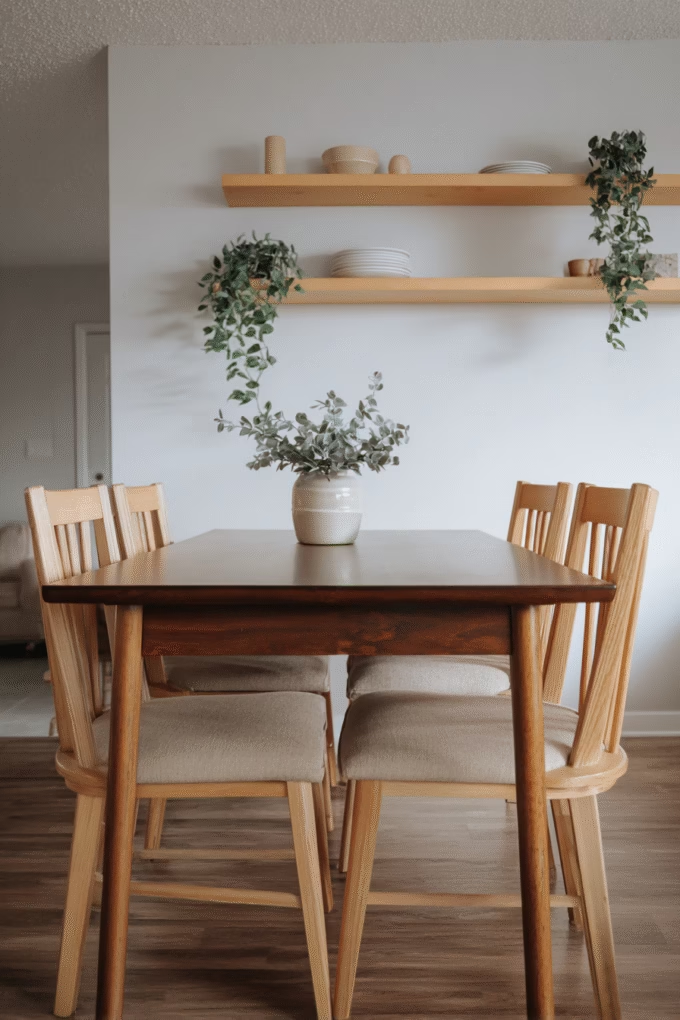
Don’t worry about matching every wood finish perfectly. Mixing light and medium wood tones adds depth and keeps your japandi dining room from looking too matchy or staged.
Stick within a similar color family—all warm tones or all cool tones—and you’ll be fine. A light oak table with medium walnut chairs or a darker table with lighter shelving both work beautifully.
The variety actually makes your space feel more collected and personal, like you’ve chosen pieces over time rather than buying everything at once from the same store.
19. Textile Wall Hanging
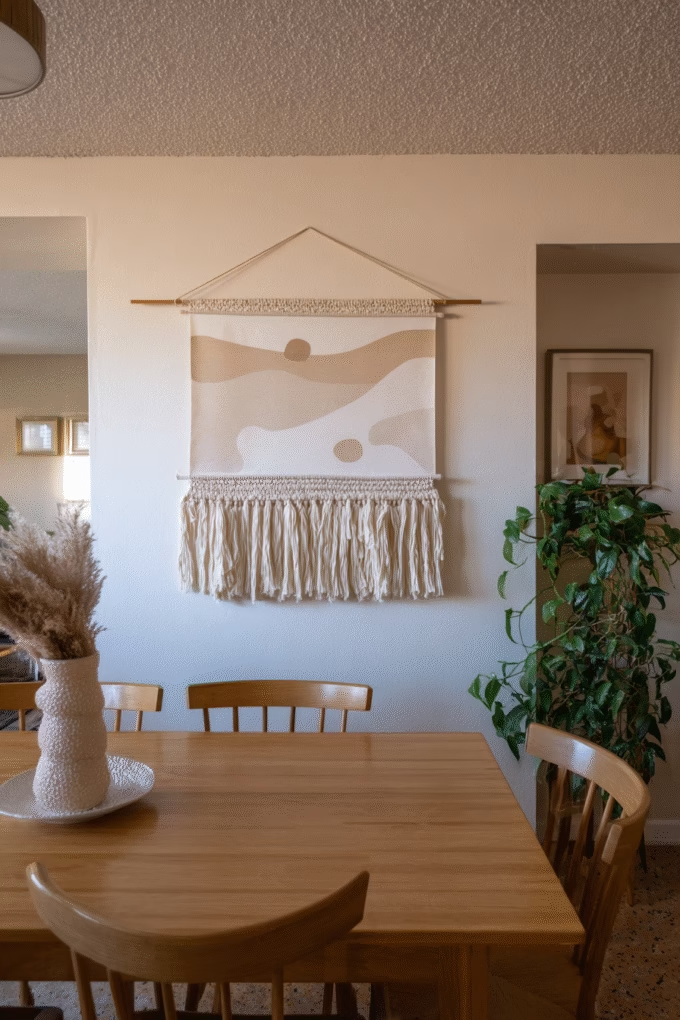
Hang a simple textile piece in natural linen or cotton for softness and texture on your wall. Choose abstract designs, simple geometric patterns, or solid neutral colors—nothing bold or busy.
This adds warmth and absorbs sound, which is especially helpful if your dining room has hard floors and minimal soft furnishings. It makes the space feel cozier and more intimate.
Keep the size modest—you want wall art, not a full tapestry situation. Something around 30 by 40 inches works well for most dining room walls.
20. Sculptural Ceramic Vase
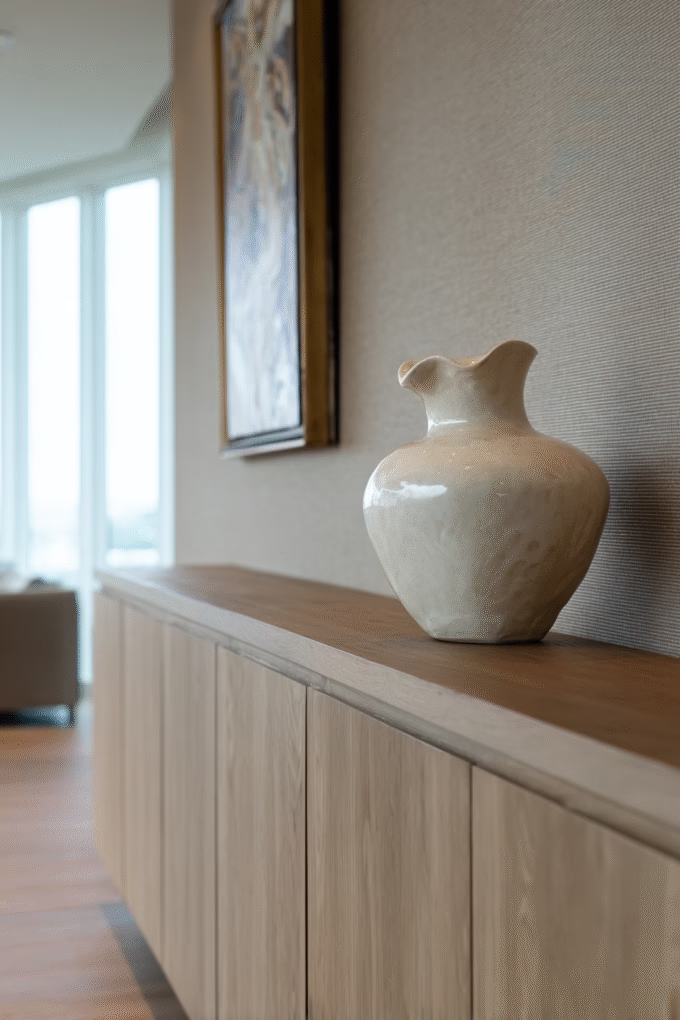
Place one beautiful ceramic vase on your table or sideboard as a sculptural element. Skip the flowers—the vase itself is the statement, with its organic shape and handmade quality.
Look for pieces with interesting curves or textures in matte cream, soft gray, or natural clay tones. Handmade pieces with slight irregularities fit the wabi-sabi philosophy perfectly.
One substantial vase beats a collection of small ones. The scale makes it feel intentional rather than like you’re just filling space with random objects.
21. Simple Area Rug in Natural Fiber
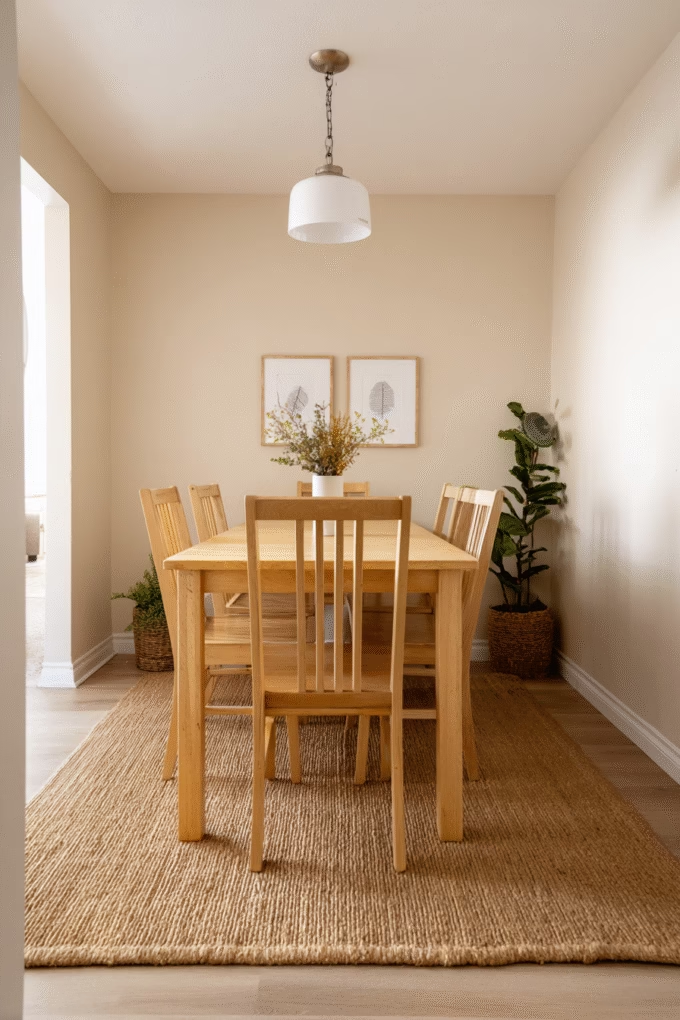
Anchor your dining space with a jute or sisal area rug in natural tan. The texture adds warmth underfoot while the neutral color doesn’t compete with your furniture or other design elements.
Size matters—your rug should be large enough that all your chairs stay on it even when pulled out from the table. Add at least 24 inches beyond your table on all sides.
Natural fiber rugs are durable and hide dirt well, but they can be scratchy. If that bothers you, layer a softer rug on top or stick with a low-pile wool rug in a neutral tone.
22. Hidden Storage Console
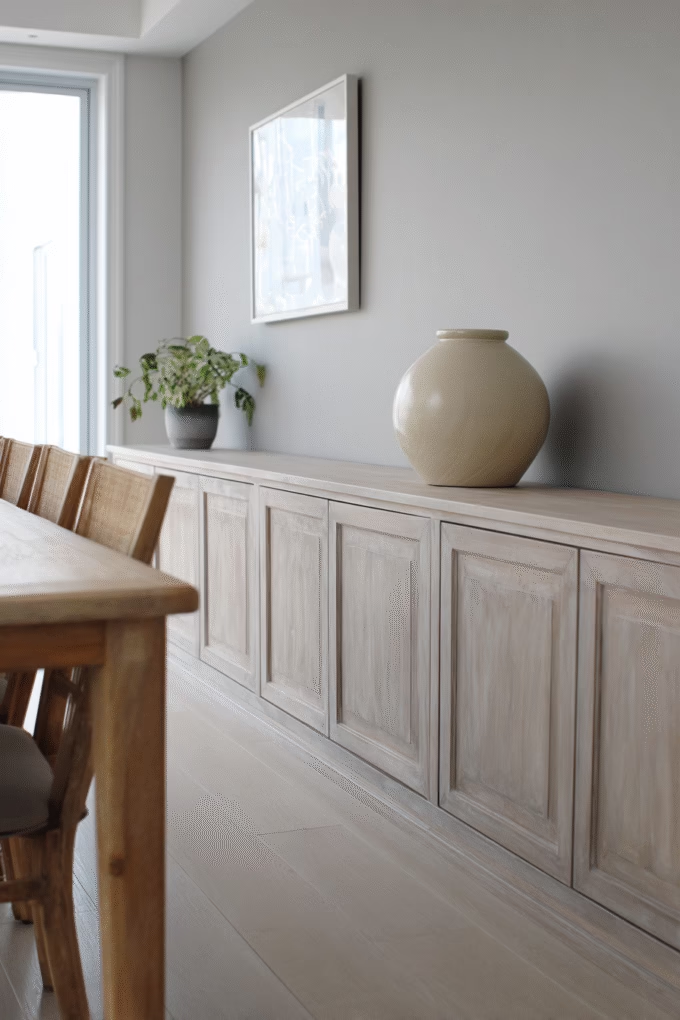
Choose a console or buffet with closed storage to keep clutter completely out of sight. The streamlined exterior maintains that clean, minimal look while hiding all your serving pieces, linens, and extras.
Look for simple cabinet doors without visible hardware—push-to-open mechanisms or recessed pulls keep the front clean and uninterrupted. Light wood with a matte or satin finish works best.
Use the top surface for just one or two decorative objects. The whole point of hidden storage is to reduce visual clutter, so don’t defeat the purpose by covering the surface with stuff.
Conclusion
Creating a japandi dining room doesn’t require a massive budget or a complete renovation. Start with natural wood furniture in light tones, stick to a neutral color palette, and add texture through natural materials like linen, jute, and ceramics.
The key is editing ruthlessly—keep only what serves a purpose or brings you genuine joy. Skip the clutter, embrace empty space, and let your beautiful materials speak for themselves.
Your japandi dining room should feel like somewhere you actually want to spend time, not like a museum where you’re afraid to touch anything. Mix warm wood tones, add soft textiles where they make sense, and create a space that feels calm without feeling cold.
Key Takeaways
- Japandi dining room style combines Japanese minimalism with Scandinavian warmth for a calm, inviting atmosphere.
- Focus on natural wood furniture, simple lines, and a neutral color palette to create peace in your dining space.
- Incorporate elements like light oak tables, low-profile benches, and bamboo pendant lights to enhance the japandi aesthetic.
- Use accessories like woven placemats, simple ceramic dishware, and hanging textile art to add texture without clutter.
- Edit your space ruthlessly—only keep items that serve a purpose or bring joy to maintain a minimal vibe.

